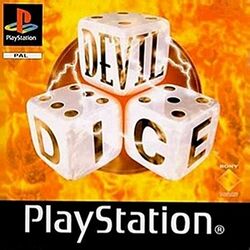Software:Devil Dice
| Devil Dice | |
|---|---|
 PAL box art | |
| Developer(s) | Shift |
| Publisher(s) | |
| Director(s) | Hiroyuki Kotani |
| Producer(s) | Tomikazu Kirita |
| Designer(s) | Yuichi Sugiyama |
| Programmer(s) | Masahiko Wada Shuichi Yano |
| Artist(s) | Seiji Yamagishi |
| Composer(s) | Kemmei Adachi |
| Platform(s) | PlayStation |
| Release | |
| Genre(s) | Puzzle |
| Mode(s) | Single-player, multiplayer |
Devil Dice (known in Japan as XI, pronounced [sai]) is a puzzle video game developed by Shift exclusively on PlayStation. It was released by Sony Computer Entertainment in Japan in 1998 and Europe in 1999, and by THQ in North America in 1998. The game is a million-seller and a demo version was released as a PlayStation Classic game for the PlayStation 3 and PlayStation Portable (PSP) on 7 November 2007.[3]
Gameplay
Devil Dice is a unique puzzle video game, where the player controls a small devil that runs around a grid covered in large dice. The player can both stand atop dice, and stand on the ground (with the dice towering above). When standing on the dice, the player can move from die to die, or can roll a die in the direction he or she runs, revealing a different face as the die rotates. Creating a group of adjacent dice with identical pips—the size of which must be at least the number of pips—causes those dice to slowly sink into the field before disappearing. Chain reactions are possible by adding additional dice to a sinking set. Different types of dice are available in some modes, with different properties to make the game more challenging.
The game features the following modes:
- Battle - pits the player against a single computer opponent, both attempting to build up chains and negate those of the opponent.
- Puzzle - mode in which players must solve puzzles (i.e., clear all dice) using only a limited number of steps or moves. Solving a whole row of puzzles allows players access to a picture that they can play on in Battle mode.
- Trial - the standard arcade-style mode, where the objective is to remove as many dice as possible (and thus score as many points as possible) before the grid completely fills with dice.
- Wars - quickfire multiplayer mode, supporting up to four simultaneous computer opponents, or five human players when using a multitap. Players damage each other as they complete chains, with the last man standing becoming the winner.
Reception
Devil Dice received favorable reviews according to the review aggregation website GameRankings.[4] Both GamePro and Next Generation were positive to the game despite noting its high difficulty.[14][lower-alpha 1][12] In Japan, Famitsu gave it a score of 30 out of 40.[8]
Famitsu reported that the title sold over 131,815 units in its first week on the market and approximately 864,844 units during its lifetime in Japan.[citation needed] GamesTM regarded it as one of "10 Underrated PlayStation Gems".[15]
The game won the award for both "Best Puzzle Game" and "Best Multiplayer Game" at the 1998 OPM Editors' Awards.[16] Hyper later named Devil Dice a second runner-up for "1999 Hyper Reader Awards" for "Best Puzzle Game", which went to Bust-A-Move 99 For Playstation and Nintendo 64.[17]
Sequels
XI Jumbo was only released in Japan exclusively on PlayStation.
XI Little was also only released in Japan exclusively on WonderSwan Color.
Bombastic (XI Go in Japan) was released in Japan, North America and Europe exclusively on PlayStation 2. It incorporates all play modes from previous releases.
Xi Coliseum was only released in Japan exclusively on PlayStation Portable. This version includes support for ad hoc wireless play between up to five players.[18]
Notes
- ↑ GamePro gave the game 3.5/5 for graphics, 3/5 for sound, and two 4/5 scores for control and fun factor.
References
- ↑ GameSpot staff (24 September 1998). "New Releases [date mislabeled as "April 28, 2000""]. Red Ventures. https://www.gamespot.com/articles/new-releases/1100-2464250/.
- ↑ Johnston, Chris (May 12, 1998). "THQ Rolls Devil Dice". Archived from the original on October 14, 2000. https://web.archive.org/web/20001014113526/http://headline.gamespot.com/news/98_05/12_thq/index.html. Retrieved November 14, 2022.
- ↑ "XI[sai Trial Version(for PS3/PSP)(Japanese Ver."] (in ja). Sony Computer Entertainment. http://asia.playstation.com/eng_hk/index.php?q=node/936. Retrieved 7 April 2008.
- ↑ Jump up to: 4.0 4.1 "Devil Dice for PlayStation". CBS Interactive. https://www.gamerankings.com/ps/197108-devil-dice/.
- ↑ Weiss, Brett Alan. "Devil Dice - Review". All Media Network. http://www.allgame.com/game.php?id=14095&tab=review.
- ↑ Chick, Tom (6 October 1998). "Devil Dice". CNET. http://www.gamecenter.com/Consoles/Sony/Devildice/.
- ↑ Edge staff (August 1998). "Xi [sic"]. Edge (Future Publishing) (61): 97. https://retrocdn.net/images/a/a1/Edge_UK_061.pdf. Retrieved 27 November 2021.
- ↑ Jump up to: 8.0 8.1 "XI[sai"] (in ja). Famitsu (Enterbrain). https://www.famitsu.com/cominy/?m=pc&a=page_h_title&title_id=11879&redirect=no. Retrieved 27 November 2021.
- ↑ "Devil Dice". Game Informer (FuncoLand) (65). September 1998.
- ↑ Mielke, James (21 July 1998). "Devil Dice Review [JP Import [date mislabaeled as "April 28, 2000"]"]. Red Ventures. https://www.gamespot.com/reviews/devil-dice-review/1900-2547287/.
- ↑ Perry, Douglass C. (29 September 1998). "Devil Dice". Ziff Davis. https://www.ign.com/articles/1998/09/30/devil-dice.
- ↑ Jump up to: 12.0 12.1 "Devil Dice". Next Generation (Imagine Media) (47): 156. November 1998. https://archive.org/details/NEXT_Generation_47/page/n159/mode/2up. Retrieved 27 November 2021.
- ↑ "Devil Dice". Official U.S. PlayStation Magazine (Ziff Davis) 2 (1). October 1998.
- ↑ Tommy Boy (October 1998). "Devil Dice". GamePro (IDG) (121): 170. https://archive.org/details/GamePro_Issue_111_October_1998/page/n169/mode/2up. Retrieved 27 November 2021.
- ↑ "Essentials: 10 Underrated PlayStation Gems". GamesTM (Future plc) (155): 156–157. December 2014.
- ↑ "1998 OPM Editors' Awards (Best Puzzle Game; Best Multiplayer Game)". Official U.S. PlayStation Magazine (Ziff Davis) 2 (5): 97–98. February 1999. https://archive.org/details/Official_US_PlayStation_Magazine_Volume_2_Issue_5_1999-02_Ziff_Davis_US/page/n95/mode/2up. Retrieved 27 November 2021.
- ↑ "1999 Hyper Reader Awards". Hyper (Future plc) (79): 42. May 2000. https://archive.org/details/hyper-079/page/42/mode/2up. Retrieved September 22, 2022.
- ↑ Gantayat, Anoop (17 January 2006). "Sony Brings Puzzlers to PSP". Ziff Davis. https://www.ign.com/articles/2006/01/18/sony-brings-puzzlers-to-psp.
External links
 |


